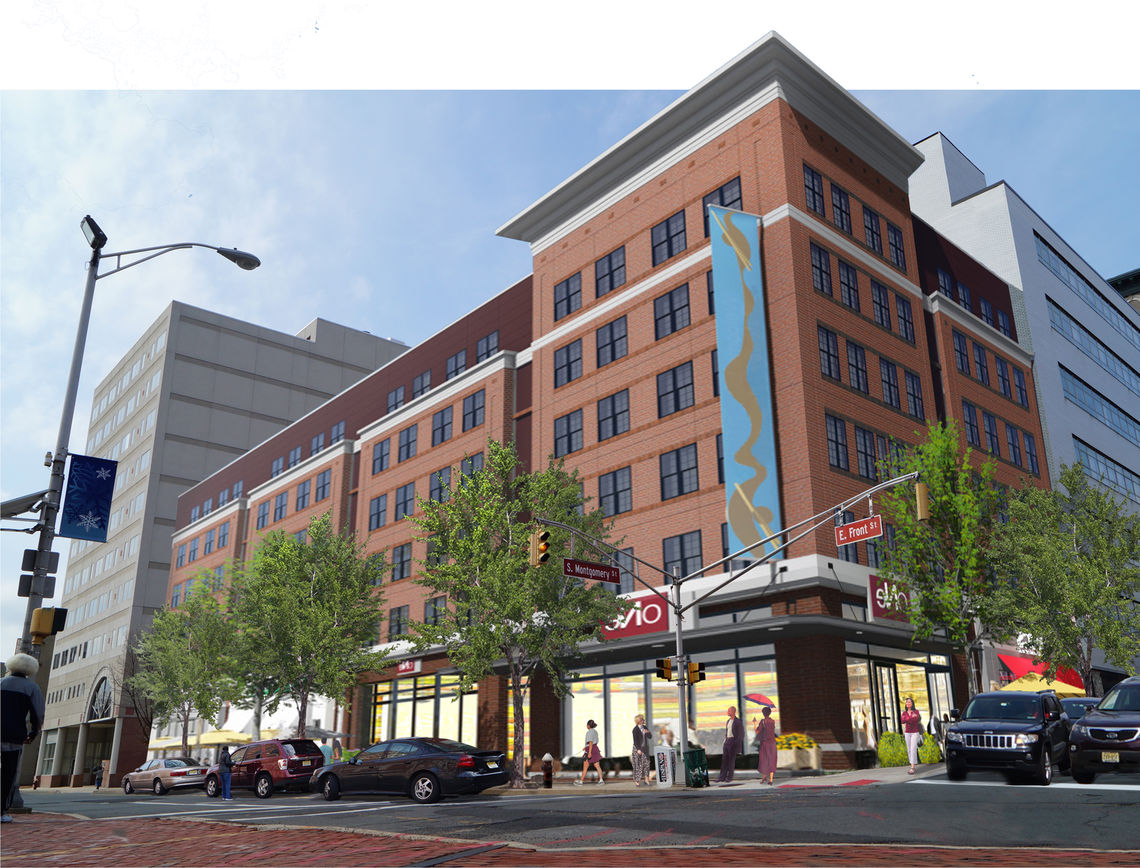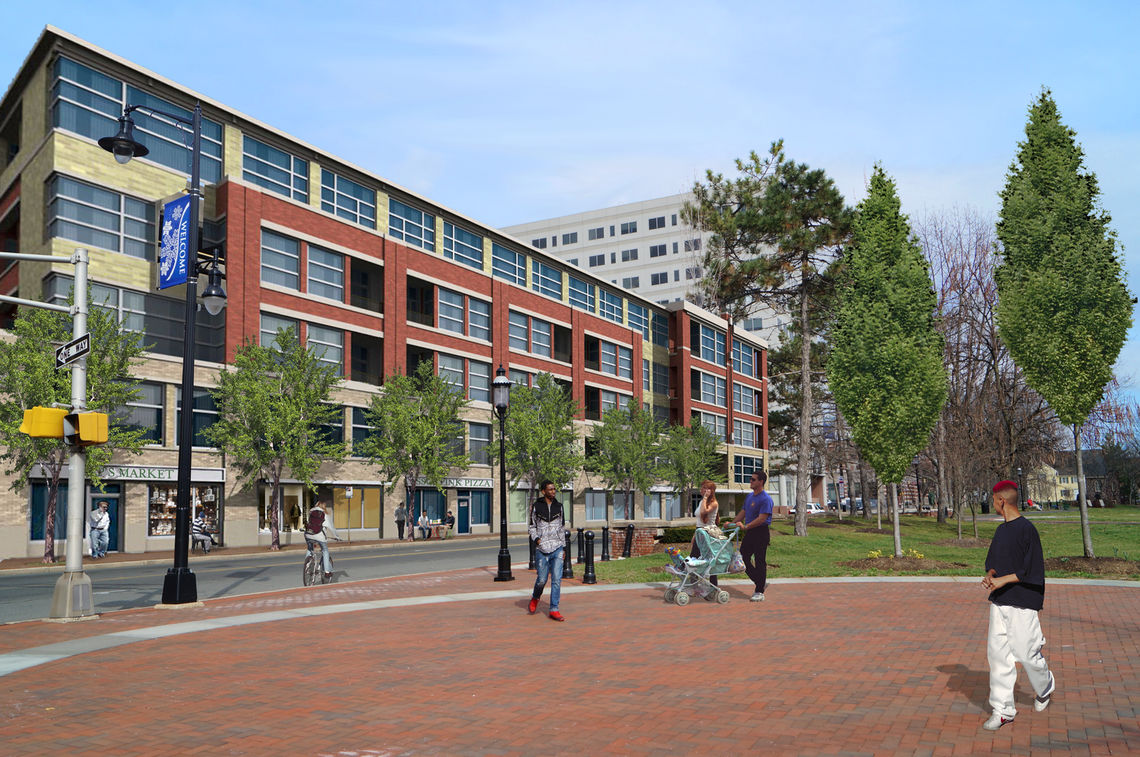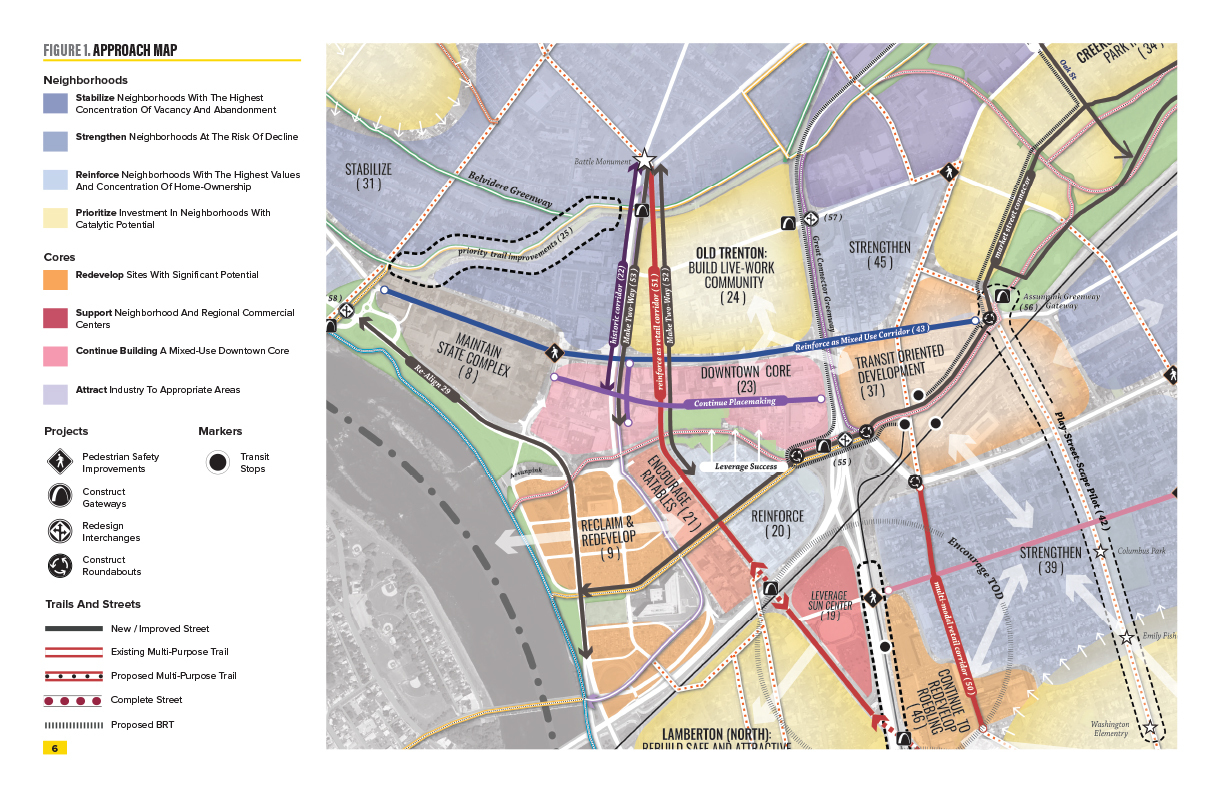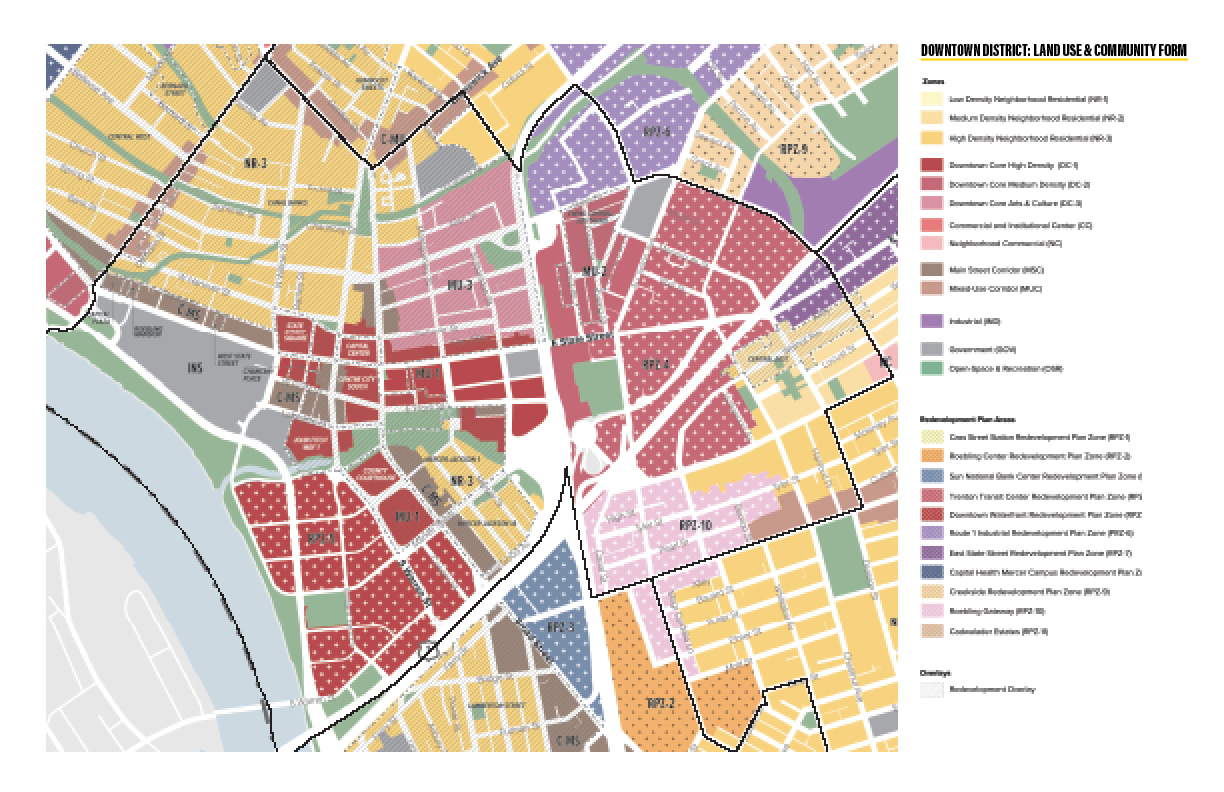Downtown Core (23)
Trenton has successfully created “place” along Warren Street and W Lafayette St, which has attracted stable businesses. In addition, the Mill Hill Neighborhood has been a resounding accomplishment, and the City should reinforce the successes achieved there (see
Reinforce Neighborhoods with the Highest Values and Concentration of Home-Ownership Initiative). In addition, Mill Hill Park and the Assunpink Creek are excellent amenities, which will be strengthened through projects such as
Assunpink Daylighting Project and
Reduce Water Pollution and Enhance the Natural Environments Initiative.
To leverage the success of these efforts , the City must encourage market-rate rental housing on prime sites in these areas. This will create new patrons for existing business and help support expanded retail opportunities. The most notable development sites include Block 204, Lot 1 (TPA Parking Garage), Block 201, Lot 3 (Bayville Holdings Parking Lot), and Block 301, Lot 3 (City Hall Parking Lot). Making the Downtown Core a choice neighborhood will require the City to Continuing Placemaking efforts currently on Warren Street down Front Street and creating gateways along Market. Moreover, the City should target the
Support and Expand Downtown Retail Initiative to this area: The city has already had success along South Warren and West Lafayette Street and there is potential to build off this success if new residential units are constructed.
Finally, the Downtown Core is home to a number of state office buildings. Efforts to Encourage Further Consolidating and Concentration of State Offices Downtown will help open up development opportunities.
Old Trenton: Build Live-Work Community (23)
Old Trenton is a historic community with the potential of attracting a critical mass of residents to downtown Trenton. The City must continue to encourage a strong residential community that can support the local economy by restoring the critical mass in Old Trenton. The Bell Telephone building will contribute to that housing provision with market-rate apartments once complete and can spur additional market-rate residential development in the area. Housing in Old Trenton must also be affordable for lower income residents, and provide opportunities for live/work space. This could occur through new infill construction, rehabbing historic homes, and adaptive reuse of structures. As such, housing rehabilitation and rental construction incentives may be effective in this area Trenton. These incentives are also part of the focus of the
Strengthen Arts, Culture, and Heritage in Trenton Initiative, as detailed in the Economic Development Report. Implementation of these initiatives is likely to require multiple investments from the City that require coordination between community groups and multiple City departments. As such, early on the City should establish a
City & Neighborhood Partnership Committee for this area to coordinate all investments in the neighborhood, not just housing.
Reinforce State Street as A Mixed Use Corridor (43)
State Street is downtown’s spine: it connects the Transit Center, Downtown Core, Old Trenton, and the State Complex. For Downtown to be successful, State Street must be an active mixed-use corridor. To achieve, this the City must implement
Support and Expand Downtown Retail Initiative which focuses on business attraction and retention, small business support, and physical improvements, such as façade improvements. At the same time, the City must
Expand Downtown Market-Rate Housing downtown. New residents will not only make the City more lively after 5:00, but with more residents spending dollars downtown, the kinds of retail that can be offered will diversify and expand. A more diverse client base downtown (that includes new residents) will give downtown retailers a better opportunity to capitalize on the thousands of employees who come to Trenton every day.
Broad Street Two-Way Redesign and Revitalization (51) (52) (53) (22)
The redesign of Broad Street downtown helps to connect many of the assets listed above. Currently, traffic is only permitted to travel north along Broad Street between E Front Street and Battle Monument. Southbound Traffic is diverted along Warren Street at Battle Monument and does not reconnect with Broad until Livingston. This drastically reduces the primacy of Broad Street as a major cross-city thoroughfare. To remedy this situation, the City should study how to make Broad Street (Route 206) and Warren Street two-way roads as far north as practical (see
Broad and Warren Two-Way Street Study). The City should also consider banners or other placemaking solutions that reinforce their identity as they traverse the city (See
Wayfinding Projects and Legibility Study). Combined with the efforts to support retail in the
Support and Expand Downtown Retail Initiative – such as a
Downtown Restaurant Fund or
Façade Improvement Program - the City could make significant progress in re-establishing Broad Street as a major commercial corridor.
A Legibility Study in this area should also consider the effect of returning Broad and Warren Streets to their pre-colonial names (King Street and Queen Street) would have on legibility. These efforts would support the creation of a “Historic Corridor” along Warren Street (22) from the Battle Monument past State St. and down brick-topped Front Street to the Old Barracks. Obtaining State and/or National Historical Park designation, with suitable requirements on private property owners along the route, would ensure that the private realm maintains historically compatible standards. The result could be a strong regional historic amenity that would likely attract visitors to the City.
Reclaim and Redevelop the Waterfront (9)
Route 29 has been re-envisioned to be a very different facility – one that will fit into its context and better serve both the transportation needs and social and economic goals of the community. The current Route 29 will be re-designed as an urban boulevard that will move traffic efficiently, but at lower, safer speeds. It will provide physical and visual connections to the river. It will form the spine of a waterfront redevelopment area in the downtown, which in turn will encourage the development of a vibrant, mixed-use community adjacent to the waterfront and serve as a magnet for private investment in the capital city. To achieve this vision, the City must execute the
Reclaim and Redevelop the Waterfront Initiative.
Maintain State Complex (8) and Encouraging Ratables (21)
The New Jersey State Capitol Complex is a major tourist destination, home to the State House, NJ World War II Memorial, State Library, State Museum, War Memorial, and many other government institutions. As a result, it is an important destination for Tourists and home to the City’s largest anchor institution. The City must ensure that this area is maintained.
The City also recognizes that the state government workforce is a key component of the Downtown economy and an important part of its growth potential and that its employees are spread out around the Downtown. Although these state employees are Downtown customers and potential future residents who will further expand the Downtown market for goods and services, the state occupies too much land in the Downtown. The City must pursue the
Encourage Further Consolidating and Concentration of State Offices Downtown Initiative and advocate that the State maintain its workforce in Trenton but occupy a smaller footprint. In buildings and areas that the State vacates, the City should actively encourage residential, office, and retail construction that is ratable.
Transit Oriented Development (37)
The Trenton Transit Center is an exceptional amenity, offering AMTRAK, NJ TRANSIT rail and River Line light rail, and SEPTA rail service. To strengthen the downtown, the City of Trenton must executive the
Trenton Transit Center Transit-Oriented Development Initiative. Several sites around the Transit Center should be considered for transit-oriented development, primarily mixed-use buildings with ground-floor retail and residential/commercial above. These locations include assembled parcels at the corner of N. Clinton Ave. and E. State St. and along E. State St., the existing parking lot on Barlow St. across from Mercer Cemetery, and the parking lot opposite Trent Center Apartments at the corner of Greenwood Ave. and Hudson St. For the City, this initiative involves the focusing efforts on encouraging and facilitating mixed-use development in these specific areas initially to take advantage of the Transit Center's location and access.
However, the Transit Center also suffers from low visibility and connection to the rest of downtown. Redevelopment of the District should include landmarks, and other wayfinding elements to further increase the visibility of the station. The transit center could also be more visible by improving the roadways leading to it. By extending Market Street to State Street, and giving the Trenton Transit Center a Market Street address, the prominence of this corridor and the station will be improved (See
Market Street Corridor Project).
As the City works to encourage development at the Transit Center, they must also work to better connect it to the rest of Downtown. Currently, the Transit Center feels disconnected from downtown, due in part to the barrier created by Route 1. Although a number of NJ TRANSIT bus routes also converge on the transit center, there is no designated central Bus Station and it may not be clear to visitors how local bus service interfaces with the Transit Center. Equally important, the connection between the Station and the Downtown is wanting: though a number of NJ TRANSIT buses connect the Transit Center to State Street, there is no primary route to make this connection and the routes are not abundantly clear. To remedy these and other issues, the City must execute the
Trenton Transit Center Connection Initiative.
Market Street Corridor Project and Interchange (55)
Making Downtown Trenton an economic and cultural hub requires better connection to the rest of Trenton as well as the region. To do this, the City should undertake the Market Street Corridor Project. The project would make Market Street a central north-south travel corridor through Trenton. The proposed street would travel from Olden along the proposed Assunpink Creek Park past the Trenton Transit Center and down to the waterfront. Such an effort would not only establish a strong local north-south connection but would serve as a complete multi-purpose street that connects major amenities throughout the City. Moreover, this project would support the
Make Trenton Easy to Understand and Navigate Initiative.To better facilitate movement between Market Street and Route 1 & Route 129, a new Route 1 Interchange (55), including a pair of roundabouts, should be constructed to serve all highway movements (See Roundabouts in Market Street Corridor Project). A roundabout at Stockton Avenue and Market Street could be designed to accommodate the Route 1 southbound off-ramp, and the Route 1 southbound on-ramp, and Route 129 southbound ramp. The roundabout at Market Street and Greenwood Avenue could serve the Route 1 northbound off-ramp and Route 1 northbound on-ramp (as the intersection does today), and possibly serve Route 129 Northbound traffic if the freight rail line is removed. The identity of Market Street could be extended by establishing a roundabout at the intersection of the Route 1 ramps and Greenwood Avenue.
Route 1 Interchange with Perry Street (57)
At the Route 1 Interchange with Perry Street, active land uses including a public park, firehouse headquarters, and an approved charter school; all generate pedestrian traffic. In addition, the trail connection to the D&R Canal, and the potential Great Connector extension along the rail corridor will also draw pedestrians and cyclists through this interchange. The interchange permits high-speed access to and from the slip ramps, and although pedestrian crossings are marked, the environment is tailored to automobile traffic. An improved interchange at this exit would not only improve safety for all users, including students but could potentially enhance the area as a gateway into the City (see
Perry Street Interchange Pedestrian Safety Study).
Bike-Pedestrian-Trail Improvements
Trenton’s geographic setting is one of the City’s greatest assets. The natural environment, including access to major waterways, made it attractive as an early settlement of the new world and help drive its development as an industrial powerhouse. Moreover, Trenton is located at the center of 75 miles of the Delaware Raritan Canal Trail system and is the proposed interconnection point of the East Coast Greenway. The City has an opportunity to attract visitors by enhancing these amenities. To do so, the City must implement all of the Multi-Modal initiatives:
A key project for the downtown will be the
D&R Canal Connection Project and the corresponding priority trail improvements (25). This project will help connect two portions of the D&R Canal, which will also better connect Trenton to the East Coast Greenway. On the other hand,
Trails Gateway Projects and
Wayfinding Projects will help those who pass through Trenton on its many trails to better connect with amenities in the City.
The
Calhoun Street Bridge Approach Project (58) would retain the existing bridge over Route 29 and replaces the cloverleaf interchange with more context-sensitive connections to Calhoun and State Streets. A properly designed approach roadway could dramatically improve the connections to the bridge. Alternatively, constructing a new bridge over Route 29, on the Calhoun Street alignment, could offer a better long-term solution. Either way, this project would significantly enhance safety and improve a key gateway into the City: the Calhoun Street Bridge is a critical bicycle and pedestrian link between Trenton and Morrisville and part of the East Coast Greenway system.
The Downtown Bicycle and Pedestrian Plan has also identified a number of trail gateways that need improvements (see
Trails Gateway Projects). The City should prioritize these improvements and include them in the
Infrastructure Maintenance and Prioritization Database.
Rezoning and Updating of Redevelopment Plans
In addition to pursuing the above efforts, the City must undertake a process of updating its land development ordinance and its redevelopment plans. (See
Land Development Ordinance Update,
Redevelopment Plans: Review and Update, and
Redevelopment Plan Reform). This document breaks down the Land Use and Community Form Plan by geography, providing information on proposed zoning, current land use, and current zoning. For more information on how zoning should be updated, see the
Land Use and Community Form Plan. Below you can explore the specific Land Use & Community Form recommendations for this district.




